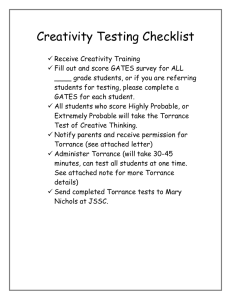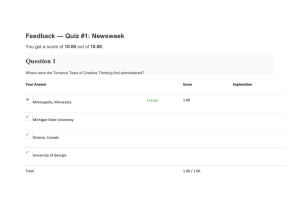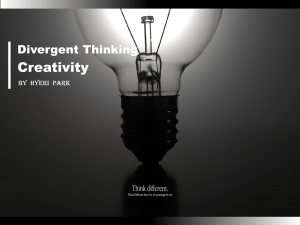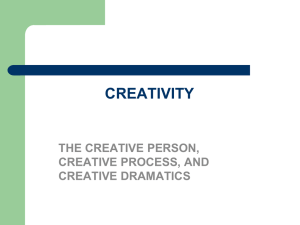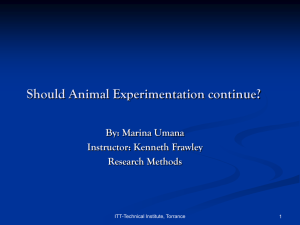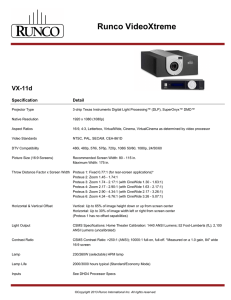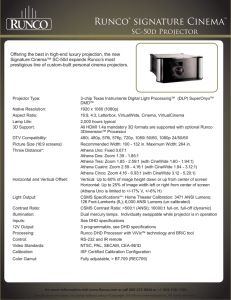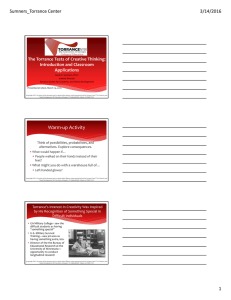Is Creativity Fundamental to Giftedness?
advertisement
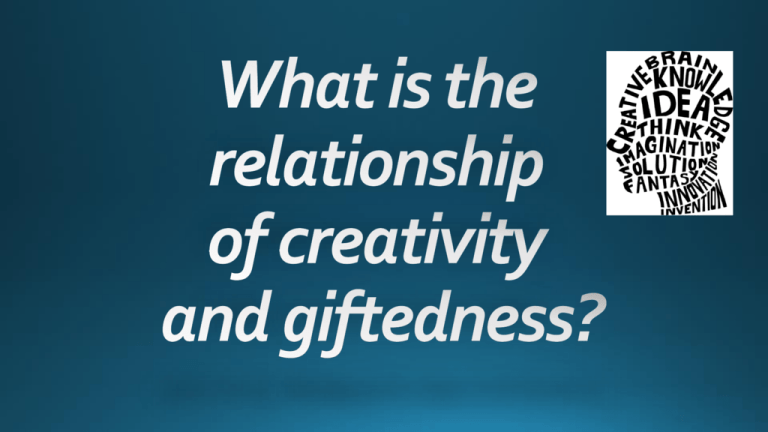
Guilford, 1961 • Creativity is independent from IQ • Divergent thinking Piirto, 1992 • Creativity is the fundamental concept of giftedness construct Cropley, 1993 • Creativity is a separate category/style of giftedness Comparison Chart on following slide: http://www.bertiekingore.com/high-gt-create.htm A High Achiever... A Gifted Learner... A Creative Thinker... Remembers the answers. Poses unforeseen questions. Sees exceptions. Is interested. Is curious. Wonders. Is attentive. Is selectively mentally engaged. Daydreams; may seem off task. Generates advanced ideas. Generates complex, abstract ideas. Overflows with ideas, many of which will never be developed. Works hard to achieve. Knows without working hard. Plays with ideas and concepts. Answer the questions in detail. Ponders with depth and multiple perspectives. Injects new possibilities. Performs at the top of the group. Is beyond the group. Is in own group. Responds with interest and opinions. Exhibits feelings and opinions from multiple perspectives. Shares bizarre, sometimes conflicting opinions. Learns with ease. Already knows. Questions: What if... Needs 6 to 8 repetitions to master. Needs 1 to 3 repetitions to master. Questions the need for mastery. Comprehends at a high level. Comprehends in-depth, complex ideas. Overflows with ideas--many of which will never be developed. Enjoys the company of age peers. Prefers the company of intellectual peers. Prefers the company of creative peers but often works alone. Completes assignments on time. Initiates projects and extensions of assignments. Initiates more projects that will ever be completed. Is accurate and complete. Is original and continually developing. Is original and continually developing. Enjoys school often. Enjoys self-directed learning. Enjoys creating. Gets A's. May not be motivated by grades. May not be motivated by grades. Assessment Author - Date Information About Assessment The Instances Test Uses Test Structure of the Intellect (SOI) Wallach and Kogan, 1965 Untimed, game-like listing of uses or descriptions of everyday objects Guilford, 1967 24 components of divergent thinking Four content areas: Figural, symbolic, semantic, behavioral Six types of product: Units, classes, relations, systems, transformations, implications One example is sketch test – draw as many objects as possible using a basic figure Torrance Tests of Creative Thinking (TTCT) Torrance, 1974, 2008 Most widely used Longest running, continually published Two forms: A/B Two sections: Figural (picture construction, picture completion, lines and circles) Verbal section (Ask and Guess, Asking, Guessing Causes, Guessing Consequences, Product improvement, Unusual uses, unusual questions, just suppose) Profile of Creative Abilities Ryser, 2007 Similar to Torrance, but uses real-world divergent thinking items Assessment Author - Date Information About Assessment Consensual Assessment Technique CAT Baer, 1994 Amabile. 1996 A type of assessment where a participant produces some type of creative product which is judged by a panel of experts in the field. Does not have standardized scores Used less in schools Creativity Checkllist Proctor and Burnett 2004 A Gifted Rating Scale A checklist for creative behaviors or characteristics No norms, only valid for comparisons Creative Behavior Inventory Hocevar, 1981 Self-reporting checklist of activities and attainments Creative Achievement Questionnaire CAQ Carson, Peterson, Higgins, 2005 Self-reporting checklist 96 items across nine domains within the arts or the sciences Abedi-Schummacher Creativity Test CT Abedi, 2002 Auzmendi, Villa, Abedi, 1996 Unique because it has a Spanish – language version Runco Ideation Behavior Scale RIBS Runco, Plucker, Lim, 2000-2001 Self-reporting checklist Example: I come up with a lot of ideas or solutions to problems. http://www.education.udel.edu/wp-content/uploads/2013/01/GiftedStudents.pdf http://www.education.udel.edu/wp-content/uploads/2013/01/GiftedStudents.pdf
